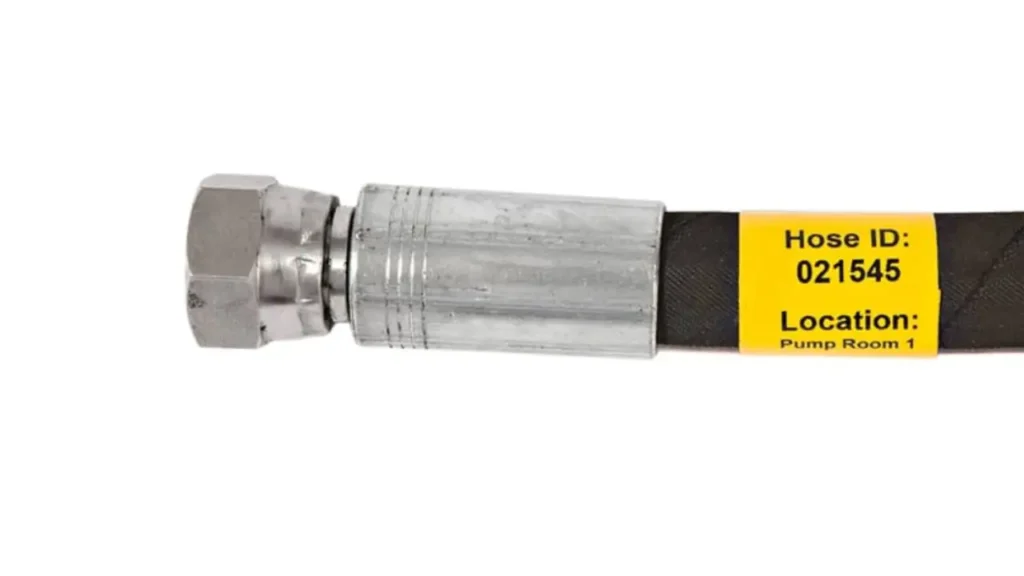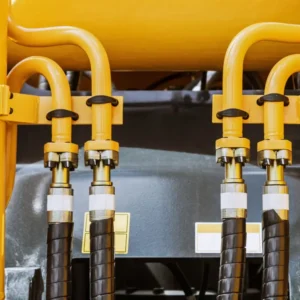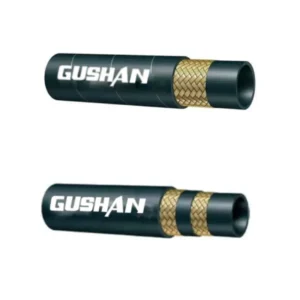Hydraulic hoses are essential components in countless industrial and mechanical applications. These high-pressure hoses transmit fluid power, enabling a wide range of operations from heavy machinery to delicate precision equipment. However, the effectiveness and safety of hydraulic systems depend heavily on the proper hydraulic hose identification and maintenance of their hoses.
Hydraulic hose labeling is a crucial aspect of ensuring optimal system performance and preventing potential hazards. By clearly labeling hoses with essential information, you can significantly reduce the risk of accidents, minimize downtime, and improve overall operational efficiency.
In this blog post, we will delve into the importance of proper hydraulic hose labeling, the key information to include on labels, and best practices for labeling your hoses.
What Are Hydraulic Hose Labels

Hydraulic hose labels are identification tags or markers used to label hydraulic hoses. These labels provide essential information about the hose, such as:
- Hose type and size: This helps ensure the correct hose is used for specific applications.
- Fluid compatibility: This prevents damage to the hose and potential hazards.
- Pressure rating: This indicates the maximum pressure the hose can safely handle.
- Installation date: This helps track the age of the hose and schedule maintenance or replacement.
- Manufacturer information: This allows for easy identification and troubleshooting.
Common Hydraulic Hose Label Forms
Hydraulic hose labels come in various forms, each with its own advantages and suitable applications:
Metal Tags:
- Durability: Made from robust materials like aluminum or stainless steel, they can withstand harsh environments, extreme temperatures, and chemical exposure.
- Permanence: Once attached, they are difficult to remove, ensuring long-lasting identification.
- Customization: They can be stamped, engraved, or printed with detailed information.
Adhesive Labels:
- Versatility: Suitable for a wide range of hose types and sizes.
- Easy Application: Simple to apply and remove if necessary.
- Customization: Available in various materials (vinyl, paper, etc.) and can be printed with barcodes, QR codes, or other relevant information.
Heat Shrink Sleeves:
- Weatherproof: Once applied and heat-shrunk, they create a tight, weatherproof seal around the hose.
- Tamper-Resistant: Difficult to remove without damaging the sleeve.
- Durability: Resistant to abrasion, chemicals, and UV radiation.
- Customization: Can be printed with information before application.
Vinyl Wraps:
- Flexibility: Can be wrapped around hoses of various shapes and sizes.
- Customization: Available in different colors and can be printed with logos, warnings, or other information.
- Durability: Resistant to abrasion, chemicals, and UV radiation.
Additional Considerations:
- Legibility: Ensure the labels are easy to read, even in low-light conditions or from a distance.
- Durability: Choose labels that can withstand the specific environmental conditions of the application.
- Compliance: Adhere to industry standards and regulations for labeling hydraulic hoses.
- Maintenance: Regularly inspect labels for damage or fading and replace them as needed.
By selecting the appropriate type of label and ensuring proper application, you can effectively identify and maintain hydraulic hoses, reducing the risk of accidents and equipment failures.
Hydraulic Hose Markers
Hydraulic hose markers, also known as hydraulic hose tags, are identification systems used to easily identify and connect hydraulic hoses to equipment. They are typically made of durable materials like polyethylene or metal and are designed to withstand harsh conditions.
Types of Hydraulic Hose Markers:
- Outback Wrap: A popular type of hose marker, Outback Wraps are color-coded sleeves that slip over hydraulic hoses. They are easy to install and remove, and they provide a clear visual identification of each hose.
- Metal Tags: Metal tags are durable and long-lasting, making them ideal for heavy-duty applications. They can be stamped or engraved with information such as hose size, pressure rating, and fluid compatibility.
- Adhesive Labels: Adhesive labels are a versatile option for labeling hydraulic hoses. They can be customized with various information and are easy to apply. However, they may not be as durable as other types of markers, especially in harsh environments.
Benefits of Using Hydraulic Hose Markers:
- Improved Efficiency: Quickly and easily identify the correct hose for each connection.
- Reduced Downtime: Minimize downtime by avoiding misconnections and troubleshooting issues.
- Increased Safety: Prevent accidents and equipment damage by ensuring proper hose connections.
- Enhanced Organization: Keep your hydraulic system organized and easy to maintain.
By using hydraulic hose markers, you can improve the efficiency, safety, and overall performance of your hydraulic system.
Hydraulic Hose ID Tags
Hydraulic hose ID tags, also known as hydraulic hose markers or labels, are essential tools for identifying and tracking hydraulic hoses in various industrial and commercial applications. These tags provide crucial information about the hose, such as:
- Hose type and size: This ensures the correct hose is used for specific applications.
- Fluid compatibility: This prevents damage to the hose and potential hazards.
- Pressure rating: This indicates the maximum pressure the hose can safely handle.
- Installation date: This helps track the age of the hose and schedule maintenance or replacement.
- Manufacturer information: This allows for easy identification and troubleshooting.
Hydraulic hose ID tags come in various forms, each with its own advantages and suitable applications:
Metal Tags:
- Durability: Made from robust materials like aluminum or stainless steel, they can withstand harsh environments, extreme temperatures, and chemical exposure.
- Permanence: Once attached, they are difficult to remove, ensuring long-lasting identification.
- Customization: They can be stamped, engraved, or printed with detailed information.
Adhesive Labels:
- Versatility: Suitable for a wide range of hose types and sizes.
- Easy Application: Simple to apply and remove if necessary.
- Customization: Available in various materials (vinyl, paper, etc.) and can be printed with barcodes, QR codes, or other relevant information.
Heat Shrink Sleeves:
- Weatherproof: Once applied and heat-shrunk, they create a tight, weatherproof seal around the hose.
- Tamper-Resistant: Difficult to remove without damaging the sleeve.
- Durability: Resistant to abrasion, chemicals, and UV radiation.
- Customization: Can be printed with information before application.
Vinyl Wraps:
- Flexibility: Can be wrapped around hoses of various shapes and sizes.
- Customization: Available in different colors and can be printed with logos, warnings, or other information.
- Durability: Resistant to abrasion, chemicals, and UV radiation.
Outback Wrap:
- Color-coded: Easily identify different hoses.
- Durable: Resistant to wear and tear.
- Easy to install: Simple to apply and remove.
Hydraulic Line Labels:
- Zip-tie based: Easy to attach to hoses.
- Weatherproof: Resistant to harsh conditions.
- Customizable: Can be labeled with specific information.
By using hydraulic hose ID tags, you can:
- Improve safety: Prevent accidents and equipment damage by ensuring proper hose connections.
- Increase efficiency: Quickly and easily identify the correct hose for each connection, reducing downtime.
- Enhance organization: Keep your hydraulic system organized and easy to maintain.
- Comply with regulations: Adhere to industry standards and regulations for labeling hydraulic hoses.
Properly labeled hydraulic hoses improve safety, efficiency, and maintenance in industrial settings.
Hydraulic Hose Labeling Systems
Hydraulic hose labeling systems are essential for maintaining safety, efficiency, and compliance in various industries. These systems provide a clear and organized way to identify hydraulic hoses, ensuring correct usage, timely maintenance, and easy troubleshooting.
Here are some popular hydraulic hose labeling systems:
1. Color-Coded Labels:
- Simple and Visual: Uses different colors to identify different hose types, fluid compatibility, or pressure ratings.
- Easy to Implement: Can be applied directly to the hose or using adhesive labels.
- Limited Information: Primarily provides visual cues, often requiring additional labels for detailed information.
2. Barcoded Labels:
- Efficient Data Storage: Stores a large amount of information in a compact barcode.
- Quick Scanning: Can be scanned with barcode readers for rapid identification and data retrieval.
- Requires Scanning Equipment: Needs specialized equipment to read and interpret the barcode.
3. RFID (Radio Frequency Identification) Labels:
- Contactless Identification: Can be read from a distance, making it ideal for hard-to-reach areas.
- Real-time Tracking: Enables real-time monitoring of hose location and condition.
- Higher Cost: Requires RFID readers and specialized software for implementation.
4. Custom Printed Labels:
- Tailored Information: Allows you to print specific information like hose type, size, pressure rating, installation date, and maintenance records.
- Durable Materials: Available in various materials like vinyl, metal, or heat-shrinkable plastic to withstand harsh environments.
- Versatile: Can be applied to hoses, equipment, or control panels.
Key Considerations for Choosing a Labeling System:
- Industry Standards and Regulations: Ensure compliance with industry-specific standards and regulations.
- Hose Type and Environment: Consider the type of hose, its operating environment, and the level of exposure to harsh conditions.
- Information Requirements: Determine the specific information you need to track, such as hose type, fluid compatibility, pressure rating, installation date, and maintenance history.
- Ease of Use: Choose a system that is easy to apply, read, and update.
- Durability: Select labels that can withstand exposure to various elements like heat, cold, moisture, and chemicals.
- Cost-Effectiveness: Consider the initial cost of the labeling system, as well as ongoing maintenance and replacement costs.
By carefully selecting and implementing a hydraulic hose labeling system, you can significantly improve safety, efficiency, and compliance in your operations.
Conclusion
Properly labeling hydraulic hoses is crucial for ensuring safety, efficiency, and longevity in your hydraulic systems. By clearly identifying the hose’s specifications and maintenance history, you can minimize downtime, reduce the risk of accidents, and optimize system performance.
Need custom hydraulic hoses tailored to your specific requirements? Our hydraulic hose manufacturer specializes in providing high-quality, custom-engineered hydraulic hoses.
Why Choose Us?
- Expert Design: Our team of experienced engineers can design hoses to meet your exact specifications.
- Premium Materials: We use only the finest materials to ensure durability and reliability.
- Strict Quality Control: We adhere to rigorous quality standards to deliver exceptional products.
- Fast Turnaround Times: We can quickly manufacture and deliver your custom hoses.
Contact us today to discuss your hydraulic hose needs.



